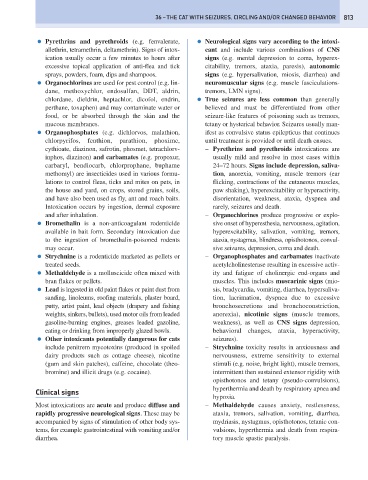Page 821 - Problem-Based Feline Medicine
P. 821
36 – THE CAT WITH SEIZURES, CIRCLING AND/OR CHANGED BEHAVIOR 813
● Pyrethrins and pyrethroids (e.g. fenvalerate, ● Neurological signs vary according to the intoxi-
allethrin, tetramethrin, deltamethrin). Signs of intox- cant and include various combinations of CNS
ication usually occur a few minutes to hours after signs (e.g. mental depression to coma, hyperex-
excessive topical application of anti-flea and tick citability, tremors, ataxia, paresis), autonomic
sprays, powders, foam, dips and shampoos. signs (e.g. hypersalivation, miosis, diarrhea) and
● Organochlorines are used for pest control (e.g. lin- neuromuscular signs (e.g. muscle fasciculations-
dane, methoxychlor, endosulfan, DDT, aldrin, tremors, LMN signs).
chlordane, dieldrin, heptachlor, dicofol, endrin, ● True seizures are less common than generally
perthane, toxaphen) and may contaminate water or believed and must be differentiated from other
food, or be absorbed through the skin and the seizure-like features of poisoning such as tremors,
mucous membranes. tetany or hysterical behavior. Seizures usually man-
● Organophosphates (e.g. dichlorvos, malathion, ifest as convulsive status epilepticus that continues
chlorpyrifos, fenthion, parathion, phoxime, until treatment is provided or until death ensues.
cythioate, diazinon, safrotin, phosmet, tetrachlorv- – Pyrethrins and pyrethroids intoxications are
inphos, diazinon) and carbamates (e.g. propoxur, usually mild and resolve in most cases within
carbaryl, bendiocarb, chlorprophane, buphame 24–72 hours. Signs include depression, saliva-
methomyl) are insecticides used in various formu- tion, anorexia, vomiting, muscle tremors (ear
lations to control fleas, ticks and mites on pets, in flicking, contractions of the cutaneous muscles,
the house and yard, on crops, stored grains, soils, paw shaking), hyperexcitability or hyperactivity,
and have also been used as fly, ant and roach baits. disorientation, weakness, ataxia, dyspnea and
Intoxication occurs by ingestion, dermal exposure rarely, seizures and death.
and after inhalation. – Organochlorines produce progressive or explo-
● Bromethalin is a non-anticoagulant rodenticide sive onset of hyperesthesia, nervousness, agitation,
available in bait form. Secondary intoxication due hyperexcitability, salivation, vomiting, tremors,
to the ingestion of bromethalin-poisoned rodents ataxia, nystagmus, blindness, opisthotonos, convul-
may occur. sive seizures, depression, coma and death.
● Strychnine is a rodenticide marketed as pellets or – Organophosphates and carbamates inactivate
treated seeds. acetylcholinesterase resulting in excessive activ-
● Methaldehyde is a molluscicide often mixed with ity and fatigue of cholinergic end-organs and
bran flakes or pellets. muscles. This includes muscarinic signs (mio-
● Lead is ingested in old paint flakes or paint dust from sis, bradycardia, vomiting, diarrhea, hypersaliva-
sanding, linoleums, roofing materials, plaster board, tion, lacrimation, dyspnea due to excessive
putty, artist paint, lead objects (drapery and fishing bronchosecretions and bronchoconstriction,
weights, sinkers, bullets), used motor oils from leaded anorexia), nicotinic signs (muscle tremors,
gasoline-burning engines, greases leaded gazoline, weakness), as well as CNS signs depression,
eating or drinking from improperly glazed bowls. behavioral changes, ataxia, hyperactivity,
● Other intoxicants potentially dangerous for cats seizures).
include penitrem mycotoxins (produced in spoiled – Strychnine toxicity results in anxiousness and
dairy products such as cottage cheese), nicotine nervousness, extreme sensitivity to external
(gum and skin patches), caffeine, chocolate (theo- stimuli (e.g. noise, bright light), muscle tremors,
bromine) and illicit drugs (e.g. cocaine). intermittent then sustained extensor rigidity with
opisthotonos and tetany (pseudo-convulsions),
hyperthermia and death by respiratory apnea and
Clinical signs
hypoxia.
Most intoxications are acute and produce diffuse and – Methaldehyde causes anxiety, restlessness,
rapidly progressive neurological signs. These may be ataxia, tremors, salivation, vomiting, diarrhea,
accompanied by signs of stimulation of other body sys- mydriasis, nystagmus, opisthotonos, tetanic con-
tems, for example gastrointestinal with vomiting and/or vulsions, hyperthermia and death from respira-
diarrhea. tory muscle spastic paralysis.

